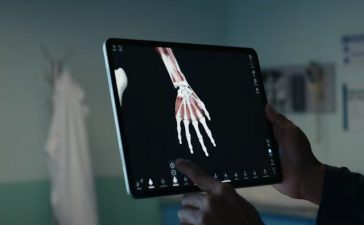I didn’t expect to be writing so effusively about the iPad after Apple’s Worldwide Developers Conference this year — then I downloaded the first developer beta of iPadOS 17 and things haven’t been the same since.
I’ve advocated for the iPad as a work tool since the original was released in 2010. I’ve used it for work tasks since about same time. I’ve done it so frequently and interchangeably with a MacBook that I don’t think I could accurately point to a single thing I’ve written in the past decade and confidently say “I did that one on my iPad.” I’ve even given advice about the best keyboards and keyboard cases for the iPad and iPad mini.
Yet the iPad has always remained something of a secondary device. I use it for work when it’s more convenient or when I’m doing a task that is more touch oriented. Even with an excellent keyboard (and sometimes a mouse), tasks that revolve around typing or multi-tasking have generally gone to my MacBook Air. Often, I have both in my bag because there are times when the iPad might work perfectly fine for a particular task, but the MacBook Air and macOS work just a little better, or faster, or more intuitively.
Similarly, when I discuss the iPad as a business device, there’s almost always a qualifier, someplace where I point out that the iPad is good for this but not for that. Or where certain tasks are better left to either a MacBook or even an iPhone. This is usually more an issue about the limitations of iPadOS or available apps than about processing power (the iPad Pro and Air now sport the same M1 and M2 processors as today’s Macs) or form factor.
Today I’m removing the qualifiers. iPadOS 17 finally makes the iPad into a laptop replacement.
Here’s how I realized that.
 Apple
AppleWith widgets, the iPad Lock Screen in iPadOS 17 can be your personal dashboard.
As did a good many Apple customers, I downloaded and installed the developer betas of both iPadOS 17 and macOS Sonoma when they became available in June. I started using iPadOS 17 first, mostly because it downloaded faster (and I wanted to install Sonoma onto a clean drive partition). I almost forgot about Sonoma. I had to force myself to put down my iPad and pick up my MacBook. After about a week, I realized that my MacBook was no longer my immediate go to for, well…, anything.
Of course, I’ve used my Air since then test out the features coming to the Mac this fall. But my default behavior has changed, and it wasn’t even a conscious shift.
I should note that I’m using a fifth-generation iPad Air (with an M1 processor) and the M2 MacBook Air, both only a few months old. It’s not like I’m comparing a brand new iPad to an older Mac and therefore skewing the experience (I bought both at the same time). That said, much of what I’m finding requires an iPad with a newer M-series chip rather than the A-series processor line that powered most older iPad and iPhone models; this means the fifth-generation iPad Air, the third generation 12.9-in. iPad Pro and the 11-in. iPad Pro.
So what’s changed?
Stage Manager
The biggest update in iPadOS 17 involves Stage Manager. Apple launched the multitasking feature on both iPadOS and macOS last year but it was pretty much a mess — particularly on the iPad. Apple really worked to make it better, and it shows.
Stage Manager allows you to view multiple apps at one time in a windowed environment as you would on macOS or Windows. They can be resized, overlap and moved around (though the system may snap windows to certain sizes and positions). You can also create workspaces that contain multiple apps and switch between them using the recent app strip on the left side of the screen.
Stage Manager now delivers much more freedom and flexibility when working with multiple apps in a single workspace. There are still limitations in the current developer betas, with windows snapping to predetermined sizes that can vary based on the type of app or snapping to certain grid positions on the screen. These limitations are fairly minor annoyances, since you’re generally able to resize and reposition windows as you want; they simply snap to a grid close to where you put them.
Then there’s the ability for multiple windows/apps to overlap. This makes the entire multitasking experience something that’s truly useful compared to the somewhat gimmicky split screen and slide over options of the past. It feels and behaves like a full-blown desktop, and working with multiple apps at once is finally a real capability for the iPad.
The ability to create workspaces with multiple apps is what really brings out Stage Manager’s potential. Since iPads have smaller screens than most Macs or PCs, the usability of multiple apps decreases as you open more of them (for me, anything beyond four becomes too cluttered to use effectively, though your preferences may vary).
 Apple
AppleStage Manager functions well in both landscape and portrait though windows may reposition as switch between them.
The recent apps strip has been part of Stage Manager from the beginning on both iPad and Mac, but I find Stage Manager isn’t the most intuitive or useful on a Mac where there are multiple multitasking options. In particular, the Spaces virtual desktop feature in macOS, in which you can swipe between multiple desktops and full-screen apps, is a better solution.
I bring this up because Stage Manager’s recent apps strip functions very much like Spaces for iPad and that frame of reference (rather than a simple list of recent apps) helps the feature really shine. Each workspace can contain multiple app windows and you can easily swap between workspaces. You can also move apps from one thumbnail in the strip to another, or you can drag the thumbnail out of the strip into the current workspace. (If you’re using an external keyboard, you can Shift-click/tap when opening apps to add them the current workspace.)
You can, of course, group apps however you like. I tend to put them together by function with social media apps in one workspace (or two since the advent of BlueSky and Threads) while Pages, Google Docs, Notes and similar apps make up another workspace.
You can also open multiple windows for the same app if the app supports doing so. I find this useful for Apple News and Safari though it really depends on the apps and individual workflows. You can also switch from running any app in a window to running it full screen, effectively making it a workspace of its own. This is something you might need to do with older apps. that require you to scroll or don’t position controls such as buttons or text boxes properly in windows; Amazon is an example of the former and Facebook can be one of the latter.
Stage Manager also works well with Picture-in-Picture support for video content. As you move from one workspace or app to another, the video remains consistently available across them. You don’t need to go looking for it when you need to pause or close it ,and you can keep watching throughout your workflow.
There are two things I would change about Stage Manager, though I don’t see Apple doing either in later versions of iPadOS 17.
One is that you can only see the four most recent workspaces in the recent apps strip along with the current workspace. This doesn’t mean you can’t have more workspaces — you absolutely can and you can switch to them by tapping the app icon on the home screen; that will bring up the workspace containing that app. But this can get confusing as you add more apps and workspaces. This limitation also exists Stage Manager in macOS; it’s all about best using the screen space available. Still, I’d like to see some type of scrolling or swiping similar to Space on the Mac.
The other issue is that iPadOS doesn’t treat the home screen as an app. You can’t view the recent apps list from the home screen. You can only see them while actively using an app. This strikes me as odd because there are times when I want to switch to the apps in a workspace from the home screen, move apps between workspaces or just see which apps are running where. This could be something that might come in later betas or it could be a limitation Apple has chosen for some reason.
External displays
The other significant feature of Stage Manager is support for external displays. Secondary display support has long existed in iOS and iPadOS, but it was limited to screen mirroring, which is useful for presentations or seeing a larger version of an iPhone or iPad screen but it doesn’t give you any additional screen real estate.
With Stage Manager, supported iPads can now utilize the display as an extension of the iPad’s screen. Apps can be dragged to the external display and organized the same way as when using Stage Manager on the iPad screen.
Better mouse support
Apple hasn’t officially said anything about mouse support in iPadOS 17 but it appears the company has tweaked it. The iPad has supported bluetooth mice for a while, but using one with a touch-first interface hasn’t always been ideal. While iPadOS 17 doesn’t change the dot-style cursor or make it behave more like the pointer on a Mac or PC, I (and several people I’ve spoken with) noticed that mouse tracking feels more accurate to the movement of your hand.
It’s a small change, but given Apple’s effort to build out Continuity features, it’s notable. Universal Control is a Continuity feature designed to make shifting between a Mac and an iPad frictionless by letting the same keyboard and mouse work with multiple devices. The shifting of mouse performance when switching is a point of friction in that system, making things not quite so universal.
Notes — now with links and PDF support
Notes gains useful features across all Apple platforms this year, but they feel most significant on the iPad. The first of these features is support for creating links between notes, which means you can easily move from one note to another related note without losing your place or concentration. It also means you can create things like a table of contents, index, or some other taxonomy. (Many third-party apps already support this in some form or another.)
 Apple
AppleIt’s easy in Notes to create links from one note to another with iPadOS 17.
This offers a powerful way to organize content and information and is much better than having to scroll through a list of notes. The effect is similar to laying out a personal website of data that links together ideas, information, media, checklists, contacts and anything else. If you already have a lot of content stored in Notes, this can be a more efficient option than trying to copy or replicate it using other apps.
Next is the ability to switch from Notes into Pages, effectively turning a note into a document. This may not seem like a major change, but if you use Notes extensively and add features like checklists, bulleted lists, formatting and media, you can now leverage all of that when you need to produce a document. You don’t have to copy, paste and recreate the content.
PDF support also gets a major boost and now acts as a full-fledged PDF editor. You don’t need an external app to view, edit, highlight, cross off, or markup PDFs. And autofill for forms is also included.
The big story: Notes is becoming much more than a pile of virtual Post-Its. It’s becoming a place to get real work done, a single resource for storing information, keeping track of things, and building out content in way that’s powerful but also centered; every user can combine features in a way that best meets their work style and needs.
AirDrop
AirDrop is having a big year across Apple devices as well; it’s the basis for NameDrop and new gestures for sharing content. It gets speed improvements, a bit more streamlined interface and the ability to finish transfers using the internet (so two users or devices don’t need to be in close proximity to one another). All of this makes AirDrop seem like a more natural way to share or move files on the desktop or over a network.
Widgets and Live Activities
Widgets are getting changes boosts that bring them more inline with Macs (and iPhones). One option coming to both platforms is the ability to place widgets freely onscreen. Until now, widgets on the iPad have behaved like big app icons on the home screen and couldn’t be moved between portrait and landscape orientations (and in macOS they were limited to Notification Center on the right side of the screen). Widgets are now interactive, so users no longer need to open an app to interact with its features, and they support live data. That makes the iPad as capable as a Mac for quickly getting a snapshot of the day, tasks, and anything else going on. (Widgets are also coming to the improved iPad lock screen.)
 Apple
AppleHome Screen widgets in iPadOS 17 can be placed more freely around app icons.
Keyboards
Support for external keyboards has long been an iPad staple. While there isn’t a lot new for keyboards (beyond Shift-click/tap with Stage Manager), they’re a crucial part of making the iPad a true laptop replacement. There are a variety of options from Apple and third-party vendors, since any bluetooth or USB keyboard (with the appropriate dongle) will work with any iPad.
I favor keyboard cases, and Apple makes a couple of very good (though rather expensive) options — my favorite is the current Apple Smart Folio case. The one suggestion I have is to try the keyboard out in person if at all possible. I’ve used a lot of them over the years and there is a lot of variety when it comes to key and keyboard size, spacing and feel. This is an accessory you want to get right or you won’t want to use it — and then the iPad doesn’t really replace anything.
Pro apps
It was a big deal when Apple launched Final Cut Pro and Logic Pro for the iPad this spring, as big a deal as when Adobe launched Photoshop for the iPad a few years ago. Today’s iPads are capable of doing pro-level work that until recently required a Mac or PC (sometimes a rather powerful one). That has changed with Apple’s Pro apps being the latest (and arguably most significant) apps to make the leap to the iPad.
iCloud Keychain for business users
This addition is important is specifically for people using an iPad to replace a work laptop. Apple has always built a wall between a user’s personal apps, data, and accounts and work apps, data and accounts whenever a device is managed by the user’s employer, provided the employer uses some form of mobile management. This is true regardless of whether the device is owned by the employee or the company and allows the employee to have both a personal Apple ID — for the App Store, iCloud, Find My and other Apple services as well as pairing devices like Apple Watch — and a work Apple ID based on the account provided by IT.
Although a business Apple ID (Apple calls these Managed Apple IDs) provides access to some Apple services, it hasn’t supported full access to iCloud for backing up and syncing work-related data as with a personal Apple ID. One notable gap was support for iCloud Keychain, which syncs passwords, passkeys and secure notes across devices, as a way to sync work-related accounts and logins. This put user devices on a different footing than computers and required users to manually input this information on their devices. With iOS and iPadOS 17 (along with Sonoma), iCloud sync is now supported across any devices or Macs connected to their work Apple ID.
The Sign In with Apple feature is also gaining traction as users will be able to decide whether to use their personal or work Apple ID to access websites and services that offer the feature.
It’s also important to note Apple will now support all Continuity features on all devices and Macs affiliated with a work Apple ID, including Handoff, Universal Control, and Continuity Camera (which allows a Mac to use another device’s camera for video chats). This last feature is coming to the iPad this year.
Apple finally gets the iPad
The truth is that the iPad has always had more potential than it could realize. The iPad Pro and Air models that share the same processors with Apple Silicon Macs are spectacular examples of this potential. What held the iPad back was that Apple wasn’t treating it as a serious workhorse. Instead it was relegated to the same OS and apps as the iPhone; that made sense in the iPad’s early days, particularly to have a full slate of apps at launch, but has made less sense with each passing generation.
Apple seems to have finally gotten the message a lot of its customers have long known: the iPad is a serious tool that needed serious software to unlock its potential. iPadOS 17 does that.
Copyright © 2023 IDG Communications, Inc.












